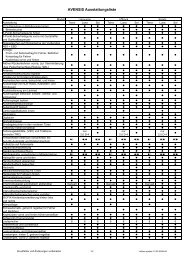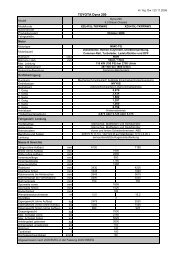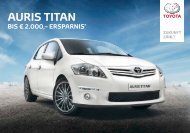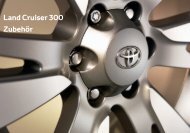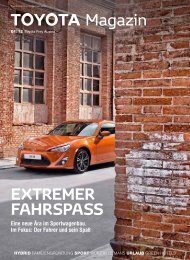You also want an ePaper? Increase the reach of your titles
YUMPU automatically turns print PDFs into web optimized ePapers that Google loves.
<strong>aim</strong>: <strong>zero</strong> <strong>emissions</strong>
Kaizen<br />
“Continuous improvement. As no process can ever<br />
be declared perfect, there is always room for improvement.”
Table of Contents<br />
Aim: <strong>zero</strong> <strong>emissions</strong>, <strong>zero</strong> waste 4<br />
Towards the ultimate Eco-car 7<br />
Clean manufacturing 10<br />
Green technologies 11<br />
The 3 Rs: Reduce, Reuse, Recycle 18<br />
The next horizon 21<br />
September 2006 edition
Residential<br />
(CO 2 )<br />
Aim:<br />
<strong>zero</strong> <strong>emissions</strong>, <strong>zero</strong> waste<br />
There are over 200 million cars in use on Europe’s roads<br />
today, providing freedom of mobility to every type of driver.<br />
European CO2 <strong>emissions</strong> World by CO2<br />
sector emmisions (2004) by sector*<br />
Yet cars are also widely associated with being harmful to the<br />
planet’s ecosystem. This can range from global warming and<br />
Petroleum<br />
refining (CO 2 )<br />
Commercial/<br />
Institutional (CO 2 )<br />
5%<br />
12%<br />
Manufacturing Industries<br />
and Construction (CO 2 )<br />
Other<br />
4%<br />
16%<br />
9%<br />
Carbon Dioxide (CO 2 )<br />
Particulate Matter (PM)<br />
Nitrogen Oxides (NOx)<br />
Volatile Organic<br />
Compounds (VOCs)<br />
Carbon Monoxide (CO)<br />
24%<br />
30%<br />
* Source EEA (European Environment Agency) Technical Report 6/2006<br />
VEhiClE<br />
Emissions<br />
greenhouse gases to smog, noise and landfill pollution. In<br />
recent years, the automobile industry has made great progress<br />
in reducing the environmental burden of motor vehicles.<br />
Transportation (CO 2 )<br />
a “greenhouse gas” that can contribute<br />
to global warming.<br />
found in soot from factories and car<br />
exhaust amongst others. Can cause<br />
respiratory diseases.<br />
causes acid rain. Also generates ozone<br />
that can contribute to photochemical<br />
smog and global warming.<br />
hydrocarbons from industrial<br />
processes, factories and cars.<br />
Contribute to smog.<br />
harmful to humans, can be fatal; now<br />
largely eliminated from car exhaust<br />
<strong>emissions</strong>.<br />
Electricity and Heat<br />
Production (CO 2 )<br />
Life cycle <strong>emissions</strong><br />
Carbon Dioxide<br />
Particulate Matter<br />
Nitrogen Oxides<br />
Volatile Organic Compounds<br />
Carbon Monoxide<br />
hOw dO CARS AffECT<br />
thE EnvironmEnt?<br />
Manufacturing<br />
Energy, Water,<br />
Waste, Landfill, Emissions<br />
End of Life<br />
Waste, Landfill
&<br />
How do cars affect the environment?<br />
Vehicle manufacturing consumes raw materials and energy, while cars<br />
produce exhaust <strong>emissions</strong> and have to be disposed of properly at the<br />
end of their lives. Reducing the impact of each of these processes is a key<br />
challenge for <strong>Toyota</strong>.<br />
Motor vehicles interact with the<br />
environment throughout their entire<br />
lifecycle – from their initial design and the<br />
way they are manufactured, to their use<br />
on the road and their eventual disposal<br />
when no longer needed.<br />
When driving, car engines release<br />
<strong>emissions</strong> into the air, influencing the<br />
chemical composition of the atmosphere<br />
we breathe and indirectly affecting<br />
weather patterns around the globe. The<br />
challenge is: How can these <strong>emissions</strong><br />
be further reduced?<br />
A second environmental impact comes<br />
from the fact that vehicles are made out of<br />
metals, plastics and other manufactured<br />
materials. Can cars be designed so<br />
that they can be recycled more easily<br />
and comprehensively? And automotive<br />
factories use energy and materials to<br />
manufacture new vehicles, and produce<br />
waste as a by-product. How can<br />
factories be designed to respond more<br />
efficiently to environmental constraints?<br />
For <strong>Toyota</strong>, minimizing these kinds of<br />
environmental impact has long been<br />
a top priority at every level of the<br />
company’s organisation and activity. The<br />
company’s environmental policy forms<br />
part of a much wider vision of sustainable<br />
development, one of the cornerstones of<br />
global economic thinking for the future.<br />
And building completely recyclable cars<br />
with <strong>zero</strong> <strong>emissions</strong> is <strong>Toyota</strong>’s foremost<br />
challenge for the years to come.<br />
Both…and morE!<br />
Much of the debate surrounding sustainable mobility, or<br />
the development of the ultimate eco-car, places a cleaner<br />
environment in opposition to economic and industrial<br />
growth. The thinking goes: you can only have one or the<br />
other, but not both. It is in <strong>Toyota</strong>’s corporate culture to work hard when<br />
confronted with these challenges, to try and achieve both and more!
6<br />
• Follow the traffic flow and anticipate<br />
what is going to happen in front<br />
of you.<br />
• Change up to a higher gear early:<br />
a higher gear always means a lower<br />
engine speed and lower fuel<br />
consumption<br />
Responsibility<br />
through<br />
innovation<br />
One of the<br />
world’s leading<br />
automobile manufacturers, <strong>Toyota</strong> sold some 8.1 million<br />
vehicles* in 200 , marketing them in over 1 0 countries.<br />
<strong>Toyota</strong> is one of the leading automotive brands in Europe,<br />
where it has been selling cars since the early 1960s<br />
and has invested over €6 billion since 1990. From its<br />
headquarters in Brussels, Belgium, the company overseas<br />
its eight European production sites, large R&D facilities<br />
and design, logistics, training and service centres. In total,<br />
<strong>Toyota</strong> employs some ,000 people in Europe, including<br />
retailers.<br />
* <strong>Toyota</strong>, Lexus, Hino & Daihatsu combined<br />
• A constant speed can give<br />
lower fuel consumption.<br />
• Don’t use your car to travel short<br />
distances<br />
• If possible, switch off your engine if<br />
you have to wait longer than<br />
0 seconds<br />
• Follow the manufacturer’s<br />
instructions and have your car<br />
serviced regularly<br />
• Check your tyre pressures on a<br />
monthly basis<br />
• Keep your windows closed and use<br />
the ventilation system<br />
• Only use electrical accessories (air<br />
conditioning, rear screen heater,<br />
etc.) when necessary, as they<br />
consume energy<br />
toyota’s Eco-drivE tips<br />
• Extra weight results in additional<br />
energy consumption (10% for<br />
ski boxes on the roof, up to<br />
0% more for a cycle rack<br />
on the roof). Remove them<br />
after use.<br />
• Plan your route in advance so<br />
you do not make unnecessary<br />
detours.<br />
• Avoid driving in town,<br />
where fuel consumption is<br />
twice as high as on the<br />
motorway.<br />
• Use of equipment such as<br />
cruise control, or a display<br />
which shows current<br />
consumption, can lead to<br />
fuel savings of up to 10%.<br />
In addition to a reputation for technological innovation,<br />
superior quality and manufacturing expertise, <strong>Toyota</strong> fully<br />
assumes its corporate responsibility for the environment<br />
and for the communities in which it operates.<br />
This commitment translates into a comprehensive vision<br />
of sustainable mobility. <strong>Toyota</strong>’s extensive Research and<br />
Development programmes examine every aspect of<br />
vehicle design, performance, safety and the information<br />
infrastructure that will underpin driving tomorrow. Finding<br />
and implementing solutions that make cars less of an<br />
environmental burden is one of the central foundations of<br />
sustainable mobility.
CNG<br />
Compressed<br />
Natural Gas<br />
Alternative<br />
Fuel Engines<br />
Towards the ultimate<br />
Eco-car<br />
Alternative<br />
Fuel HV<br />
Hybrid Technology<br />
Biofuels<br />
Synthetic Fuels<br />
In 2020 it is estimated there will be some 1.2 billion cars on the<br />
road, nearly twice the current number. Car makers must make the<br />
right decisions today to ensure that this growth does not lead to<br />
a drastic increase in exhaust <strong>emissions</strong> and the greenhouse gas<br />
carbon dioxide (CO 2 ). <strong>Toyota</strong>’s approach to exhaust <strong>emissions</strong><br />
is to explore simultaneously a broad variety of solutions for<br />
developing cleaner, greener vehicles. The reason is that different<br />
countries and communities have different driving conditions,<br />
available fuel, vehicle infrastructure and legislation.<br />
Diesel<br />
Engines<br />
Diesel Hybrid<br />
Vehicle<br />
Diesel Particulate<br />
NOx Reduction<br />
Common Rail Direct Injection<br />
Plug-in HV<br />
Diesel HV THS II<br />
DPNR<br />
Common Rail DI<br />
FCHV<br />
Fuel Cell<br />
Hybrid<br />
Vehicle<br />
<strong>Toyota</strong><br />
Hybrid System<br />
D-4<br />
Direct Injection<br />
4-Stroke Petrol Engine<br />
VVT-i<br />
Variable Valve<br />
Timing with Intelligence<br />
Lean-Burn<br />
Gasoline<br />
Engines<br />
<strong>Toyota</strong> is committed<br />
to developing hybrid<br />
systems as the core<br />
technology for ecocars,<br />
combining different<br />
power sources<br />
in ways that maximize<br />
the strengths of each.<br />
EV<br />
Electric<br />
Vehicle<br />
Electrical<br />
Energy
8<br />
EURO 3<br />
EURO 4<br />
<strong>Toyota</strong> is investing in all these technologies in parallel.<br />
Each forms a step forward towards the ultimate eco-car.<br />
This ideal target would generate <strong>zero</strong> 1997<strong>emissions</strong><br />
from its<br />
engine, and be totally recyclable. Kyoto But Protocol while pursuing this<br />
ideal, it is important to meet thedrafted real needs of society1998<br />
today and tomorrow, and therefore <strong>Toyota</strong>’s approach<br />
Date of application<br />
After 1/1/2000<br />
1/1/2005<br />
Petrol (in grammes/km)<br />
100<br />
80<br />
60<br />
40<br />
20<br />
&<br />
One of the most promising technologies for reducing<br />
<strong>emissions</strong> in conventional cars is known as hybrid<br />
technology, since it advantageously combines the<br />
benefits of two types of power source instead of relying<br />
on just one. For example, a petrol engine can be<br />
combined with an electric motor.<br />
In certain contexts of vehicle use, other<br />
types of low-emission engine technologies<br />
are also proving effective, although they<br />
are not yet as mature or versatile as petrol<br />
and diesel-powered engines. These include<br />
fuel cells (where hydrogen is used to generate<br />
electricity) and compressed natural gas engines.<br />
EU directives on<br />
exhaust emission limits<br />
CO NOx + HC<br />
EURO 3 EURO 4<br />
How can the environmental impact of a car be measured?<br />
Provided we look at the whole lifecycle of a car, we can accurately<br />
measure its overall impact in terms of materials, production, <strong>emissions</strong><br />
and end-of-life. This Life Cycle Assessment then makes it easier to<br />
produce cleaner cars according to clear targets.<br />
EU Directive:<br />
sets emission targets<br />
for new cars as of<br />
2005 (Euro 4)<br />
NOx<br />
2.30 0.20 0.15<br />
1.00 0.10 0.08<br />
For Petrol cars<br />
is to deploy the appropriate engine technology to<br />
produce... the right car for the right place at the right<br />
time.<br />
EURO 3<br />
EURO 4<br />
2006<br />
All <strong>Toyota</strong> engines meet<br />
Euro 4 Directive for<br />
<strong>emissions</strong><br />
Date of application<br />
After 1/1/2000<br />
CO NOx<br />
2008/9<br />
European, Japanese and<br />
Korean car makers to<br />
reduce average CO2<br />
to 140 g/km<br />
Diesel (in grammes/km)<br />
NOx + HC Particulate<br />
Matter<br />
0.64 0.50 0.56 0.05<br />
1/1/2005 0.50 0.25 0.30 0.025<br />
CO<br />
HC + NO x<br />
PM<br />
NO x
how environmental<br />
is your car?<br />
To achieve lower <strong>emissions</strong> and greener vehicles on the<br />
way toward the ultimate eco-car, it is essential to measure<br />
progress. <strong>Toyota</strong> has therefore developed its Ecological<br />
Eco-VAS<br />
at work<br />
When a new <strong>Toyota</strong> vehicle is<br />
planned, the Chief Engineer sets<br />
quantitative targets for reducing its<br />
environmental impact. Assessment covers a wide range<br />
of items. It starts with materials – including the elimination<br />
of substances of concern such as lead or chrome<br />
– components and production methods. It continues<br />
by examining fuel efficiency and <strong>emissions</strong> during the<br />
vehicle’s use. And it factors in the amount of materials that<br />
can be recovered on disposal, as well as overall reduction<br />
of <strong>emissions</strong> throughout the vehicle’s life cycle.<br />
All findings from these assessments are kept in a computer<br />
database that can be accessed to compare and contrast<br />
progress in reaching Eco-VAS targets, and confirm the<br />
environmental conformity of a new vehicle based on the<br />
concept of total Life Cycle Assessment (LCA).<br />
Vehicle planning<br />
Eco-VAS at work<br />
Designing and<br />
prototype building<br />
Vehicle Assessment System, or Eco-VAS. This is a<br />
comprehensive approach to assessing a vehicle’s whole<br />
life cycle – from production, through use to disposal – in<br />
terms of its impact on the environment, starting at the<br />
early stages of development, before the vehicle is actually<br />
built. <strong>Toyota</strong> began using Eco-VAS in 200 , bringing the<br />
system to a high level of implementation in 200 .<br />
By enabling development teams to evaluate the<br />
environmental impact of a new vehicle ahead of its actual<br />
production, it will be easier for <strong>Toyota</strong> to ensure constant<br />
step by step improvements on the road to the ultimate<br />
eco-car.<br />
Production<br />
Target setting Target-achievement<br />
Target-achievement status check<br />
Evaluation-results feedback<br />
status con�rmation<br />
9
The production of vehicles, engines and transmissions in<br />
factories inevitably has an impact on the environment. To<br />
ensure that car manufacturing can make more with less,<br />
<strong>Toyota</strong> developed its world-famous <strong>Toyota</strong> Production<br />
System (TPS) several decades ago. Over the years, TPS<br />
has also evolved to include new environmental targets.<br />
It is now applied in <strong>Toyota</strong>’s production facilities all over<br />
Europe.<br />
toyota’s production system...<br />
• eliminates waste<br />
• reduces energy usage<br />
• minimises use of raw materials<br />
• delivers standardised quality<br />
by...<br />
• applying best practice in<br />
all processes (“Yokoten”)<br />
• continuous improvement<br />
(“Kaizen”)<br />
• going to the source to find the<br />
facts (“Genchi Genbutsu”)<br />
• just-in-time production, by<br />
‘pulling’ products through the<br />
production line<br />
• active involvement from<br />
all team members<br />
10<br />
Greener<br />
manufacturing<br />
in the <strong>Toyota</strong> Prius<br />
Clean<br />
manufacturing<br />
Constant efforts to improve standards<br />
throughout the workplace have radically<br />
reduced the environmental impact of<br />
production at our plants.<br />
Since 2001:<br />
• Total energy usage per car has<br />
been reduced by 37% across all of<br />
<strong>Toyota</strong>’s European manufacturing<br />
plants.<br />
• Water usage has been reduced in<br />
Europe by 34%.<br />
• Packaging waste has been reduced<br />
through the full use of returnable or<br />
recyclable packaging.<br />
• Volatile organic compound<br />
<strong>emissions</strong> per square metre of<br />
painted surface have been reduced<br />
by 21%.<br />
Aim: <strong>zero</strong> <strong>emissions</strong><br />
through TPS<br />
For example: <strong>Toyota</strong>’s vehicle plants in both the U.K. and France, have achieved the<br />
ambitious target of delivering <strong>zero</strong> waste to landfill.* Applying TPS principles, staff<br />
carefully examined how production waste was created, and invented appropriate<br />
solutions to reduce, reuse or recycle all the ‘waste’ materials generated. This has resulted<br />
in a 73% reduction of waste going to landfill since 2001.<br />
The manufacturing process for the new Prius model has been organized to reduce the amount of energy needed<br />
for building the car. CO 2 <strong>emissions</strong> during the manufacturing process are cut by 31% compared to the previous<br />
Prius production plant. Special Eco-plastic made from plants to provide floor mats is used. This further reduces CO 2<br />
<strong>emissions</strong> during manufacturing. The batteries are smaller and more efficient, resulting in 33% less CO 2 <strong>emissions</strong><br />
during manufacturing when compared to the previous generation Prius.<br />
the toyota prius is 90% recycable!<br />
* Zero waste to landfill: less than 3% of 1997 amount of waste disposal to landfill
Green Technologies<br />
Petrol and diesel engines are highly efficient, but they come at a price. They emit CO 2<br />
and other gases and particles that pollute the atmosphere and might influence longer-<br />
term climate patterns. <strong>Toyota</strong> is therefore committed to developing technologies that<br />
reduce <strong>emissions</strong> to much lower levels. Since petrol and diesel engines will probably<br />
continue to form the major source of automotive power in the years to come, a major<br />
effort is being made to reduce the environmental impact of these technologies.<br />
For example, <strong>Toyota</strong> has re-examined the whole structure<br />
of the internal combustion engine to identify specific ways<br />
in which petrol and diesel engines can burn less fuel more<br />
efficiently, and so emit less CO 2 and other unwanted<br />
gases.<br />
This has led to the development of integrated intelligent<br />
technologies that use advanced solutions inside engines<br />
to improve the management of fuel and driving operations.<br />
One of these is Variable Valve Timing-intelligent<br />
(VVT-i), which uses less fuel than comparable petrol<br />
engines and emits less carbon dioxide, nitrogen oxides<br />
and hydrocarbons.<br />
Another is <strong>Toyota</strong>’s Common Rail Diesel technology<br />
(known as D-4D), which injects a precise amount of fuel<br />
directly into the combustion chamber to deliver more<br />
efficient combustion and better fuel economy. These both<br />
help reduce CO 2 levels in exhaust <strong>emissions</strong>.<br />
<strong>Toyota</strong> has also made significant advances in developing engines that are powered by alternative energy<br />
sources. One of the most promising approaches is to combine two different power sources in a single system<br />
to exploit the performance potential of both. This is known as hybrid technology, and forms one of the most<br />
promising development paths on <strong>Toyota</strong>’s eco-car roadmap.<br />
11
Do diesel engines pollute more than petrol engines?<br />
Diesel engines use less fuel and overall produce less CO 2 than petrol<br />
engines. However, they produce more particulate matter and nitrogen<br />
oxides than petrol engines. Advanced technologies can improve the<br />
efficiency and cleanliness of both petrol and diesel engines.<br />
Advancing<br />
with diesel<br />
Mile for mile, diesel engines are more efficient as a power<br />
source than petrol engines. But this efficiency comes at a<br />
price. Diesel exhaust contains higher quantities of Particulate<br />
Matter (mostly consisting of un-burnt carbon compounds), as well<br />
as nitrogen oxide. Over the years, <strong>Toyota</strong> has developed a<br />
number of engine technologies that lower diesel’s impact.<br />
Common Rail Diesel technology (D- D), for example, reduces<br />
CO 2 <strong>emissions</strong>. Special catalysts have been developed to reduce<br />
particulate matter and nitrogen oxides. <strong>Toyota</strong>’s D- D<br />
and exhaust gas recirculation technology help reduce the<br />
presence of hydrocarbons, carbon monoxide and particulate<br />
matter in vehicle exhaust.<br />
In 200 , <strong>Toyota</strong> revolutionised the diesel engine by combining<br />
these different technologies into a single new integrated solution<br />
called <strong>Toyota</strong> Diesel Clean Advanced<br />
Technology (<strong>Toyota</strong> D-CAT). This<br />
advanced concept dramatically<br />
reduces particulate matter and<br />
nitrogen oxides resulting in the<br />
world’s cleanest diesel engine<br />
technology! In 200 , <strong>Toyota</strong> D-CAT<br />
was featured in a brand-new 2.2litre<br />
high-power (1 DIN hp) diesel<br />
engine, built in Poland. <strong>Toyota</strong>’s<br />
new 2.0-litre D- D 12 diesel engine<br />
is available with a diesel particulate<br />
filter, reducing particulate<br />
<strong>emissions</strong> even further.<br />
<strong>Toyota</strong>’s challenge is to ensure that<br />
diesel engines’ <strong>emissions</strong> performance<br />
will eventually be equivalent to<br />
petrol engines.<br />
12<br />
&<br />
The D-4D 2.2-litre, <strong>Toyota</strong> D-CAT engine integrates special technologies<br />
to produce very low NOx and particle <strong>emissions</strong><br />
EGR Valve<br />
Exhaust Port Injector<br />
Variable Nozzle Turbocharger<br />
Air fuel ratio sensor<br />
Oxidation Catalyst<br />
EGR Cooler<br />
Piezoelectric common-rail injection<br />
DPNR Catalyst<br />
High Power Diesel Engine<br />
• 2.2-litre, in-line 4-cylinders<br />
Pressure Difference Sensor<br />
NOx storage reduction catalyst<br />
Gas Temperature Sensors
hybrid<br />
hybrid<br />
Technology<br />
Electric<br />
No single engine technology<br />
or fuel can deliver an optimal<br />
solution to the <strong>emissions</strong><br />
problem. All have their shortcomings.<br />
Petrol engines emit less nitrogen oxides than diesel<br />
engines, and produce insignificant levels of particulate<br />
matter. Diesel engines, on the other hand,<br />
are more fuel efficient and therefore produce less<br />
carbon dioxide than petrol engines. Among non-petroleum<br />
power sources, electric vehicles, for example,<br />
are clean, but cannot deliver satisfying overall<br />
drive performance, acceptable driving range, and have<br />
to be recharged.<br />
But what if it were possible to combine different types<br />
of power sources and make them work together to enhance<br />
their respective benefits and reduce their obvious<br />
shortcomings?<br />
This leap forward has been made through the creation<br />
of <strong>Toyota</strong>’s hybrid technology, now one of the company’s<br />
core vehicle technologies.<br />
If you drive 25,000 km a year in a Prius,<br />
you will save over 1 tonne more<br />
CO2 when compared to a<br />
similarly-sized diesel car.<br />
+<br />
+<br />
+<br />
+<br />
Diesel<br />
or<br />
or<br />
Alternatives<br />
Fuels<br />
Petrol<br />
or<br />
Fuel Cell<br />
Hybrid technology can be applied effectively to improve<br />
the efficiencies of a variety of power trains irrespective<br />
of the type of fuel used (gasoline, diesel, alternative fuels<br />
or fuel cell vehicles).<br />
Hybrids not only deliver lower <strong>emissions</strong> and reduced<br />
fuel consumption, but they are completely silent when<br />
operating electrically and deliver impressive driving performance.<br />
The revolutionary breakthrough achieved by hybrid<br />
technology is the intelligent management of the energy<br />
flows from two different power sources so that each dimension<br />
of driving – acceleration, open road, braking<br />
and stop-and-go – is performed in an optimal way.<br />
This highly innovative solution consists of a petrol engine<br />
designed to minimize fuel consumption, combined<br />
with a <strong>zero</strong>-emission electric motor matched to a nickel<br />
metal hydride electric battery pack to provide additional<br />
power. Both of these power sources work together<br />
under the supervision of a sophisticated power<br />
management controller to deliver maximum overall<br />
driving efficiency.<br />
One tree (1) absorbs around 14kg (2) of CO2<br />
each year. So you'd be doing the annual<br />
workload of a forest with 71 trees.<br />
(1) Measured using Japanese cedar<br />
(2) CO 2 equivalent<br />
1
1<br />
toyota &<br />
hyBrid:<br />
• Launched the world’s first mass-produced hybrid<br />
car (<strong>Toyota</strong> Prius) in 199 .<br />
• Is the world’s leading manufacturer of hybrid<br />
vehicles and has the largest hybrid model line-up.<br />
• Intends to double the number of models in its<br />
hybrid line-up by the early 2010s.<br />
• Over 00,000 hybrid vehicles sold worldwide<br />
(July 2006).<br />
• Over 0,000 hybrid vehicles sold in<br />
Europe (July 2006).<br />
• Target of reaching annual hybrid sales<br />
of 1 million units by the early 2010s.<br />
ordinary driving<br />
Full-throttle<br />
acceleration<br />
deceleration/braking stop-and-go<br />
Runs with electric motor<br />
and engine in most fuel-efficient<br />
configuration<br />
Engine Engine Engine<br />
Engine<br />
Engine power +<br />
electric motor power<br />
Engine Engine Engine<br />
lectric motor Battery BatteryElectric<br />
Battery Electric motor motor Electric motor Battery Electric motor Battery Battery Electric Battery Electric motor motor Electric motor<br />
High fuel-efficiency driving<br />
Battery<br />
Electricity is generated,<br />
and partly recharges the battery<br />
Battery Battery Battery<br />
The <strong>Toyota</strong> Prius has already captured 90%<br />
of the world market for hybrid technology,<br />
having been on the market since 1997.<br />
The Prius was voted the 2005 European<br />
Car of the Year – a strong endorsement for<br />
environmentally beneficial hybrid technology.<br />
Energy recovered<br />
and stored<br />
Prius:<br />
an eco-pioneer<br />
Engine stops automatically,<br />
and can run on electricity alone<br />
Battery Electric motor Battery BatteryElectric Battery Electric motor motor Electric motor<br />
Zero fuel consumption
hybrid<br />
Synergy drive<br />
Hybrid Synergy Drive® (HSD) is the concept behind<br />
the new generation of hybrid vehicles from the <strong>Toyota</strong><br />
brand, including the <strong>Toyota</strong> Prius, the world’s bestselling<br />
hybrid vehicle. HSD combines driving pleasure<br />
and performance with fuel economy, low <strong>emissions</strong><br />
and silent driving. The word “synergy” extends to the<br />
higher synergy between the petrol engine and electric<br />
motor to power the vehicle. The electric motor is now<br />
more powerful, allowing a higher ratio of electrical/<br />
petrol usage. The results are more performance with<br />
greatly improved efficiency.<br />
the benefits of<br />
hybrid synergy drive<br />
in the prius<br />
• Excellent driving performance:<br />
acceleration similar to a mainstream<br />
D-segment (1) diesel engine.<br />
• Low fuel consumption:<br />
. litres/100 km – equivalent<br />
to a B-segment (1) diesel car.<br />
• Lower <strong>emissions</strong>:<br />
CO 2 <strong>emissions</strong> of 10 g/km in the<br />
combined cycle (2) , down from<br />
120 g/km for the previous generation.<br />
• silent driving:<br />
HSD can run on the electric motor only,<br />
offering a completely silent<br />
driving experience.<br />
(1) B-segment cars are compact cars like the <strong>Toyota</strong> Yaris.<br />
D-segment cars are larger, more powerful cars such<br />
as the <strong>Toyota</strong> Avensis.<br />
(2) City and highway driving.<br />
1.5-litre Petrol engine<br />
Uses special technology to<br />
extract more energy from petrol<br />
combustion.<br />
Regenerative braking system<br />
Uses electric motor<br />
as generator to convert<br />
braking energy into electricity.<br />
Inverter<br />
Converts DC from battery to<br />
AC for driving the motor.<br />
Battery<br />
Charged by the engine via the<br />
generator when cruising, and<br />
by electric motor when<br />
braking. Never needs to be<br />
plugged in.<br />
Electric motor<br />
Permanent-magnet<br />
technology to produce 50kW<br />
output.<br />
Power Split Device<br />
Splits power between engine,<br />
motor, generator and wheels.<br />
1
16<br />
lexus<br />
hybrid<br />
drive<br />
The Lexus brand first introduced<br />
hybrid power<br />
trains with the RX 400h<br />
in May 2005. Since<br />
then, Lexus has gained<br />
more ground with its European<br />
hybrid strategy,<br />
both by launching the GS 450h in May 2006 and<br />
presenting the company’s forthcoming flagship,<br />
the LS 600h, in May 2007.<br />
Hybrid technology is attracting customers to the<br />
Lexus brand who are looking for a realistic alternative<br />
to mainstream technology. In addition to the<br />
quietness, smoothness and refinement of hybrid<br />
power trains, Lexus customers appreciate the<br />
powerful and linear acceleration combined with<br />
segment-leading environmental performance. To<br />
reflect the importance of its hybrid strategy, Lexus<br />
has adopted a new brand name that will more<br />
clearly identify its advanced hybrid technology<br />
and philosophy: Lexus Hybrid Drive.<br />
Alternatives<br />
to fossil fuels<br />
The great advantage of alternative energy sources is<br />
that they can drastically cut <strong>emissions</strong> for cars being<br />
driven. However, since many of the technologies<br />
involved are not yet fully mature, and are still too<br />
costly to be implemented into a broad range of<br />
cars, the majority of them require further research<br />
and development before they come to market.<br />
<strong>Toyota</strong> has led the way in developing a number of these alternative technologies as cleaner solutions for<br />
sustainable mobility, and has already proven that innovative solutions can be commercialised for specific uses.
inside an Fchv<br />
CO2 output from oil well to car wheel<br />
Petrol vehicle<br />
Diesel vehicle<br />
Petrol Hybrid<br />
<strong>Toyota</strong> FCHV<br />
(target)<br />
Hydrogen<br />
(Gasoline vehicle = 1)<br />
0 0.2 0.4 0.6 0.8 1.0<br />
Well-to-Tank CO2<br />
Tank-to-Wheel CO2<br />
In the Japanese 10-15 test cycle, <strong>Toyota</strong> in-house testing<br />
FCHV: Hydrogen fuel<br />
Well-to-Tank CO2 = CO2 emitted from the oil well until the fuel arrives at the fuel station<br />
Tank-to-Wheel CO2 = CO2 emitted by a vehicle during use, including refueling<br />
4<br />
3<br />
Water<br />
Air<br />
2<br />
1<br />
1. Fuel cell stack<br />
2. Battery<br />
3. Control unit<br />
4. Motor<br />
hydrogen fuel cells – as pure as water<br />
One of the most promising technologies developed<br />
to use alternative energy is ‘fuel cell’. A fuel<br />
cell works by combining two common elements -<br />
hydrogen and oxygen - to generate electricity that<br />
powers an electric motor. The by-products of this<br />
reaction are only water vapour and heat, making<br />
this technology the ultimate <strong>zero</strong> emission solution<br />
for vehicle use, even though the actual production<br />
process for hydrogen is not emission-free. <strong>Toyota</strong><br />
has been conducting research into fuel cells since<br />
1992. It believes fuel cell driven vehicles will become<br />
a mainstay of mobility in the future.<br />
Vehicles equipped with fuel cells and using <strong>Toyota</strong>’s<br />
hybrid system configuration are 2 - times more<br />
efficient than petrol-powered cars in terms of fuel<br />
tank-to-wheel efficiency.<br />
In 2002, <strong>Toyota</strong> was the first automobile manufacturer<br />
to commercialise Fuel Cell Hybrid Vehicles<br />
(FCHVs) in Japan and the U.S. They are equipped<br />
with the <strong>Toyota</strong> FC Stack, a completely in-house<br />
developed fuel cell. The full commercialisation of<br />
fuel cell vehicles, however, will require the establishment<br />
of a hydrogen supply network similar to that<br />
for petrol and diesel fuel - a large-scale and costly<br />
undertaking. But while the market of fuel cell powered<br />
vehicles is limited for the immediate future, their<br />
potential remains proven and clear.<br />
<strong>Toyota</strong> has been researching a number of other<br />
sources of cleaner fuel for some time now, in its<br />
quest for the ultimate eco-car.<br />
For example, <strong>Toyota</strong> has researched Compressed<br />
Natural Gas (CNG) for over two decades, with<br />
limited-scale commercialisation. Compared to<br />
conventional diesel and petrol vehicles, natural<br />
gas powered vehicles emit very small amounts of<br />
Particulate Matter, and much less carbon dioxide.<br />
However, CNG requires very large storage tanks<br />
for the fuel, and tends to deliver less energy than<br />
conventional fossil fuels, limiting its long-term applications<br />
to very specific driving contexts such as<br />
bus or taxi transport in city centres. Gas-to-Liquid<br />
(GTL) – a synthetic diesel fuel produced from CNG<br />
- is another promising energy alternative, as it uses<br />
existing diesel fuel infrastructures. It provides the<br />
benefit of further <strong>emissions</strong> reduction and the better<br />
fuel economy of the latest clean diesel engines<br />
– such as <strong>Toyota</strong> D-CAT and <strong>Toyota</strong>’s Diesel Particulate<br />
Filter.<br />
<strong>Toyota</strong> also supports the use of alternative fuels including<br />
bio-fuels for cars to help reduce fossil fuel<br />
consumption and to prevent climate change.<br />
Gsi - GEar shiFt indicator<br />
Fuel consumption in vehicles can also be reduced by making more efficient use of existing<br />
technology.The “Gear Shift Indicator” is a good example. It’s a technology that <strong>aim</strong>s to encourage<br />
fuel efficient driving behaviour. It does this by indicating the optimum point to change gear for<br />
eco-driving. By doing so, awareness of fuel efficient driving is increased. Depending on the<br />
circumstances, fuel consumption can be reduced by over %.<br />
1
The 3 Rs:<br />
Reduce, Reuse, Recycle<br />
For car makers, truly sustainable mobility also<br />
means manufacturing vehicles and processing<br />
them at the end of their lifetime in ways that ensure<br />
maximum energy efficiency and minimum waste.<br />
The 2015 target is to have 85% of the vehicle<br />
weight being reused or recycled and 10% energy<br />
recovery, leaving the remaining 5% for disposal.<br />
End-of-life<br />
vehicles<br />
18<br />
&<br />
End-of-life vehicles (ELVs) contain<br />
materials ranging from steel and<br />
rubber to plastic and solvents. Some of these<br />
contain Substances of Concern (SoCs) which<br />
would contaminate the soil and the groundwater<br />
reserves if an ELV is simply thrown away.<br />
<strong>Toyota</strong>’s Eco-VAS (Vehicle Assessment System)<br />
sets targets and consistently tracks measures<br />
for limiting SoCs and reducing other forms of<br />
environmental burden. And further improvements<br />
will follow in the future.<br />
toyota makes vehicle recycling easier:<br />
1. Designing cars for easier recovery.<br />
2. Manufacturing cars with recovery in mind.<br />
3. Recovery of used parts and components that are<br />
replaced during the life of a vehicle.<br />
4. Minimising the remaining waste of an ELV.<br />
How does recycling reduce CO 2 <strong>emissions</strong>?<br />
Making new cars involves the use of many materials, from metals and<br />
synthetic products to cardboard, which all have to be first produced<br />
industrially. By recycling materials where and when appropriate, the<br />
amount of energy used can be reduced, along with factory <strong>emissions</strong>.
The recycling<br />
Process<br />
The European End-of-<br />
Life Vehicle Directive<br />
(Environmental Directive<br />
2000/ /EC) was adopted<br />
by the European Parliament<br />
and Council on September 18, 2000, to improve<br />
the recycling and recovery of ELVs, and<br />
to increase the environmental performance of all<br />
economic players in the processing chain. Since<br />
then, all EU Member States have enacted laws<br />
to implement this Directive.<br />
designing for recycling<br />
In order to simplify the dismantling process, <strong>Toyota</strong><br />
designed a new ‘Easy to Dismantle Mark’.<br />
This mark is added to vehicle parts clearly indicating<br />
certain points that assist in initial dismantling,<br />
such as the positions at which large resin<br />
parts can be easily separated and the locations<br />
at which holes can be drilled for removing fuel.<br />
Cars contain plastics that are hard to recycle.<br />
<strong>Toyota</strong> has therefore developed a special recyclable<br />
plastic called <strong>Toyota</strong> Super Olefin Polymer,<br />
or TSOP, that can be used to make car bumpers<br />
and other parts which can then be recycled<br />
many times over.<br />
IDIS, a practical tool<br />
to dismantle cars<br />
Pioneer Recycling<br />
Plant in Japan<br />
Using shredder<br />
residue effectively<br />
Automobile Recycling<br />
Technical Centre<br />
<strong>Toyota</strong> Prius battery<br />
recycling system<br />
Eco-VAS ‘design<br />
with care’<br />
DISPOSAL<br />
Replacement<br />
remanufactured<br />
parts<br />
Build recoverability<br />
into design<br />
LOPM<br />
DEVELOPMENT PRODUCTION<br />
RECYCLING<br />
RECYCLING<br />
CAR<br />
CAR<br />
USE<br />
Dealer waste<br />
collection system<br />
Design for recycling<br />
Rubber recycling<br />
and reuse<br />
Application of<br />
recycled materials<br />
Greening spare parts<br />
Batteries, tyres, and oil filters all need to be replaced<br />
during a vehicle’s lifetime. <strong>Toyota</strong> has<br />
therefore set up a waste collection system that<br />
retrieves used parts from European dealers and<br />
sends them back for recovery. In addition, <strong>Toyota</strong>’s<br />
remanufactured parts offering now includes<br />
air conditioning compressors, power steering<br />
racks, cylinder heads, starters, automatic transmissions,<br />
alternators, engines and clutch kits.<br />
substances of concern<br />
Lead, together with Mercury, Cadmium and<br />
Hexavalent Chromium, are heavy metals that<br />
cause long-term damage to the environment if<br />
buried unprocessed in landfills. In line with the<br />
year 2000 European Union directive on End-of-<br />
Life Vehicles which limits the use of these Substances<br />
of Concern (SoCs) in materials and vehicle<br />
components starting in 200 , <strong>Toyota</strong> now<br />
uses a number of <strong>zero</strong>-lead car parts and anticorrosion<br />
coatings, mercury-free lighting and<br />
switches, and asbestos-free friction materials<br />
and engine gaskets. It also avoids SoCs in various<br />
kinds of paints and in solvents.<br />
Resin recycling<br />
and reuse<br />
19
20<br />
the end is a new beginning<br />
<strong>Toyota</strong> has created a dedicated Automobile Recycling<br />
Technical Centre in Japan to experiment<br />
with new techniques for dismantling vehicles for<br />
recovery. This has resulted in the construction<br />
of an operational Automobile Shredder Residue<br />
Recycling Plant which in 2001 achieved <strong>Toyota</strong>’s<br />
voluntary goal of developing the technology for<br />
a commercial system to achieve a high recovery<br />
rate for component materials.<br />
Once Europe’s end-of-life cars have been shredded<br />
to extract usable materials, they still leave<br />
2 million tonnes of residue behind. Traditionally<br />
this has been buried in landfill or incinerated. But<br />
the European ELV and Landfill Directives now in<br />
force limit the use of this solution.<br />
Plastic recycled from<br />
polypropylene is used in<br />
four separate parts.<br />
Recycled plastic for the<br />
bumper, instrument panel<br />
and other coverings.<br />
In Japan, <strong>Toyota</strong> has<br />
developed ways of using<br />
certain foam products<br />
found in vehicle<br />
residue to create recycled<br />
soundproofing<br />
products. Thanks to<br />
the high-quality characteristics<br />
of automotive glass, powdered glass<br />
from shredder residue is recycled into tiles for<br />
use in landscaping pavement.<br />
Shredder residue that cannot be recycled can<br />
nevertheless be melted down into extremely<br />
small packs for landfill, reducing once more the<br />
environmental impact of vehicles on future generations.<br />
<strong>Toyota</strong> Avensis<br />
and the 3 Rs<br />
Two parts use plastic<br />
recycled from<br />
production waste.<br />
Renewable materials<br />
(recycled cotton and wool)<br />
for sound absorption and<br />
insulation.
The next horizon<br />
Cars have benefited society for over a century. During this time, car makers have<br />
explored a variety of technologies, and fine-tuned the internal combustion engine into<br />
the high-performance machine we know today. For <strong>Toyota</strong>, the automobile’s future will<br />
be dedicated to improving relations between cars, people and the environment.<br />
<strong>Toyota</strong> has promised to<br />
achieve sustainable mobility.<br />
And our company is<br />
well recognised for its<br />
innovative products<br />
and technologies.<br />
<strong>Toyota</strong> is developing<br />
these advanced<br />
technologies in order<br />
to protect the<br />
environment, and<br />
ensure its continued<br />
growth. Our company<br />
recognises the link between<br />
mobility, a sustainable<br />
environment and economic<br />
growth, and believes that<br />
the growth of our business depends on<br />
the success of sustainable mobility.<br />
Through the concepts it builds today for<br />
tomorrow’s society, <strong>Toyota</strong> is seeking to<br />
expand the scope of personal mobility while<br />
ensuring minimal environmental impact. For<br />
example, <strong>Toyota</strong> has developed the i-swing,<br />
a personal, light-weight mobility vehicle that<br />
creates a seamless transformation between<br />
vehicle and human movement. The batterypowered<br />
i-swing minimizes occupied space<br />
and energy consumption with its ultra compact<br />
size, operating in two-wheel mode when<br />
moving among people in the city and switching<br />
21
22<br />
to three-wheel mode on the road with other vehicles. The driver of the<br />
i-swing can remain in permanent contact with their vehicle through a mobile<br />
phone or a PC, bringing personal mobility to another level.<br />
Beyond its product range, <strong>Toyota</strong> recognises the importance of good<br />
corporate citizenship and is taking concrete steps to positively impact<br />
European society.<br />
In 2002, our company established a fund – the <strong>Toyota</strong> Fund for Europe – to<br />
enhance its good corporate citizenship through social contribution activities<br />
in Europe. The strategic focus of this Fund is linked to our core corporate<br />
sustainability challenges: environment, road safety and technical education.<br />
<strong>Toyota</strong>’s advanced technologies already provide a proven new platform<br />
for building an even wider range of cleaner and more<br />
fuel-efficient engines, while offering an<br />
enticing driving experience.<br />
And other technologies such<br />
as fuel cells promise longterm<br />
alternatives for specific<br />
applications.<br />
With its effective production<br />
methods, leading technology<br />
and constant attention to<br />
customer requirements, <strong>Toyota</strong><br />
is developing many solutions to<br />
the global challenge of sustainable<br />
mobility.<br />
RAiSinG<br />
EnViROnmEnTAl<br />
AwAREnESS<br />
ThROUGh ThE<br />
TOYOTA FunD<br />
FOR EuROPE:<br />
Green pack<br />
Since 2000, <strong>Toyota</strong> has<br />
supported the Regional<br />
Environmental Center for Central<br />
and Eastern Europe in the<br />
development and production of<br />
the Green Pack – a unique multimedia<br />
environmental education<br />
kit designed to be used by<br />
schools.<br />
schools for sustainable<br />
development<br />
In 200 , <strong>Toyota</strong> Europe launched<br />
the Schools for Sustainable<br />
Development programme in<br />
partnership with the NGOs<br />
Groundwork UK and the<br />
Environmental Partnership<br />
(CE Europe). The project <strong>aim</strong>s<br />
to promote local community<br />
environmental actions by giving<br />
schools the opportunity to<br />
make improvements in their<br />
neighbourhoods.<br />
Eco-schools<br />
This project, rolled out in<br />
Western Europe, is <strong>aim</strong>ed at<br />
promoting innovation in schools´<br />
environmental problem solving,<br />
through the awarding of grants<br />
projects on sustainable mobility.
Genchi Genbutsu<br />
“Going to the source to find the facts to make correct decisions,<br />
build consensus and achieve goals.”
<strong>Toyota</strong> Motor Europe<br />
Corporate Affairs<br />
Avenue du Bourget 60 - 1140 Brussels, Belgium<br />
Tel. +32 2 745 21 11 / Fax +32 2 745 20 68<br />
e-mail: pr@toyota-europe.com<br />
www.toyota.eu<br />
This report has been printed on CyclusPrint © paper, produced with 100% recycled pulp and without the use of OBA (Optical Bleaching Agent).









